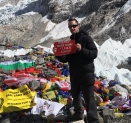Never think you are alone
+61 041523665(24/7)
The Climate in Nepal
The seasons in Nepal are pretty much the same as Europe, opposite of the Australian seasons. In January it's cold, while in July you could make do with shorts and t-shirt. The climate of Nepal is moderate which means the winters are dry and the summers are hot. But because of the huge range in altitude and landscape, climate of Nepal differs significantly throughout the country.
Generally, monsoon season lasts from around the end of June to the end of August. About 80 per cent of the rainfall occurs during this period throughout the country but the remainder of the year is dry. Spring (March to May) and autumn (September to November) are the most pleasant seasons. Winter (December, January, and February) temperatures drop down with a high level of snowfall in the high mountain areas.
Summer, monsoon and late spring temperatures range from 28ºC (83ºF) in the hills to more than 40ºC (104ºF) in the Terai (southern plains). In winter, average maximum and minimum temperatures in the Terai range from a brisk 7ºC (45ºF) to a mild 23ºC (74ºF). The central valleys experience a minimum temperature but not often falling below freezing point and a chilly 12ºC (54ºF) maximum during the winter.
Kathmandu Valley has a mild climate most of the year. Summer temperatures range from 67-81°F (19-27°C), and in winter temperatures are between 36 and 68°F (2-20°C). During the monsoon season in August, the average rainfall is between 7.8-14.7 inches (200-375mm) in Kathmandu. May and June can be very hot and humid until the monsoon rains. In spring (March to April) and autumn (October to November) the temperatures are pleasant with occasional short bursts of rain, while November to February are dry, but can be very cold, especially at night.
Best time to visit Nepal
Spring (March, April, May) and autumn (Sept, Oct, Nov) are the best time of the year to visit Nepal. During this time, the weather is pleasant with efficient sunlight and warmth. The sky is clear which means that you can truly enjoy the remarkable Nepalese landscape complete with the Himalayan vista.
During the monsoon (June, July, Aug) although there will be no problem for trekking, the issue could be of less visibility and rain. But, for a keen botanist, monsoon is a blessing as the higher valleys, mountains and meadows blossom with flowers and abundant vegetation. You can trek in winter (Dec, Jan, Feb) as well especially in the hilly regions but as you reach higher elevations it is much more colder with snow-fall. If you don’t necessary enjoy crowds, trekking during the monsoon or winter or choosing more solitary trekking destinations could be your options. Note that due to global warming there has been a change in the regular climate worldwide and Nepal is no exception. Please be open to unpredictable weather conditions as well.

Back home now after my adventure in the mountains. I just want to say a big thank you to Sushant Dahal and Ashmi...